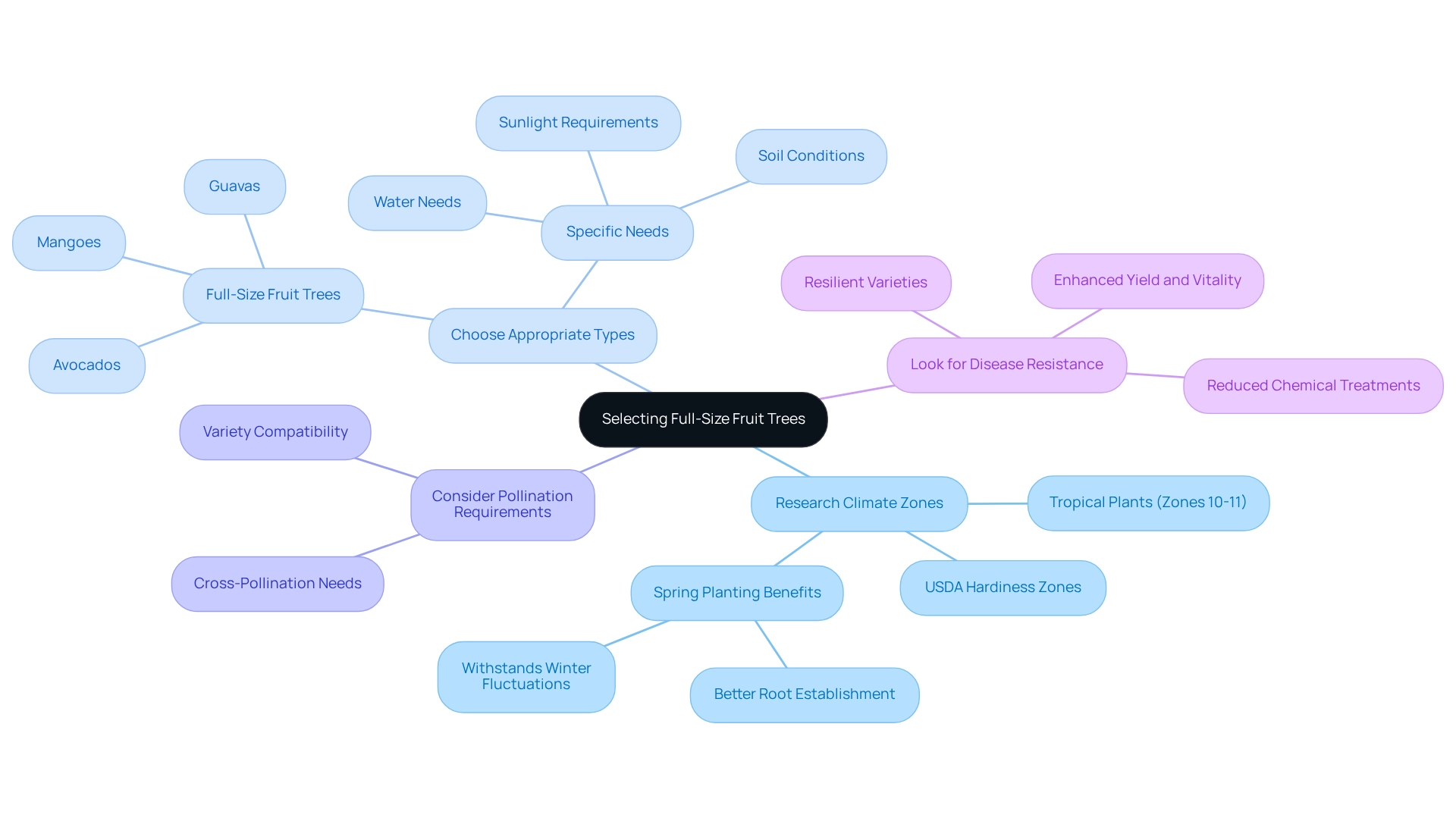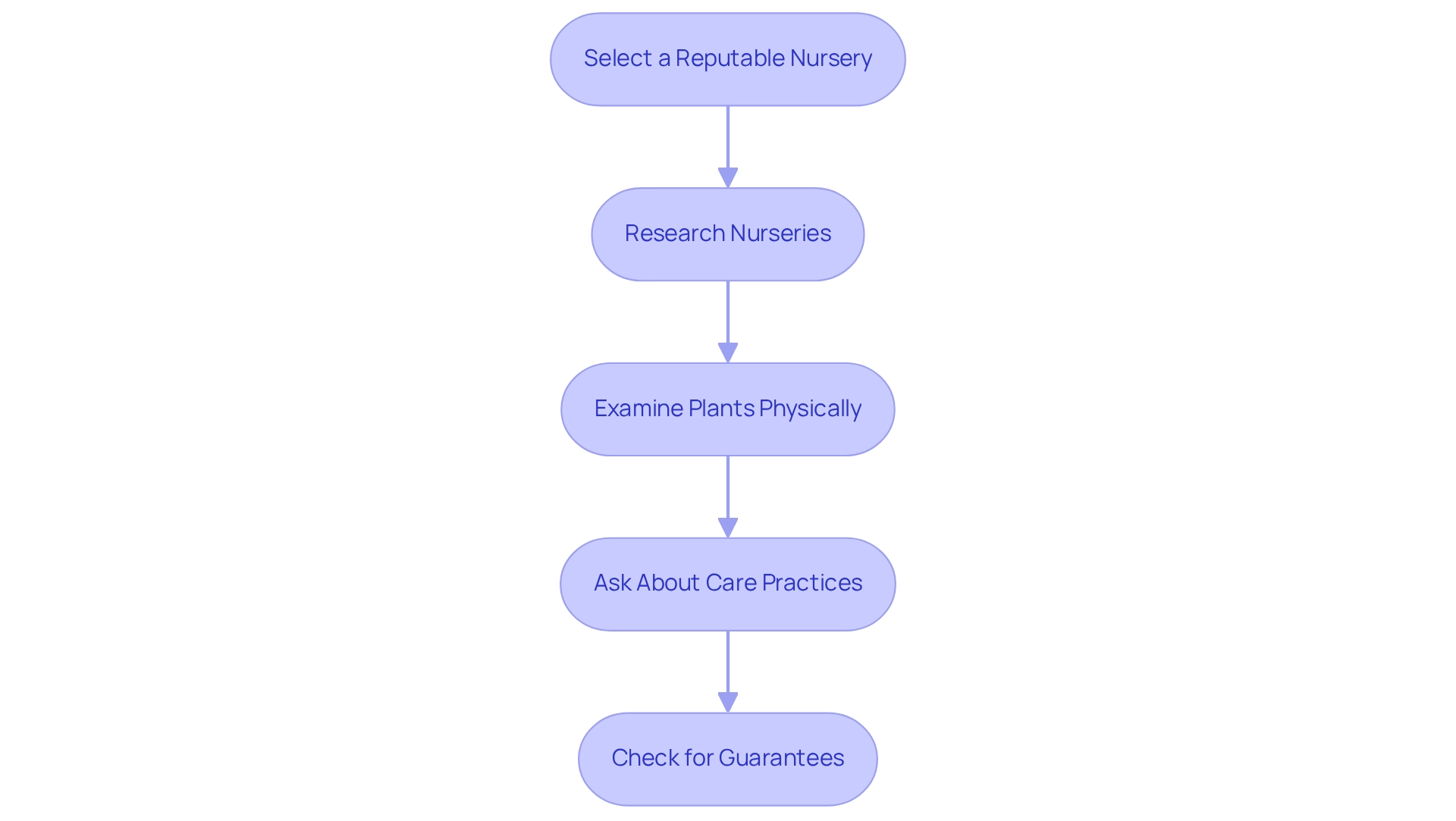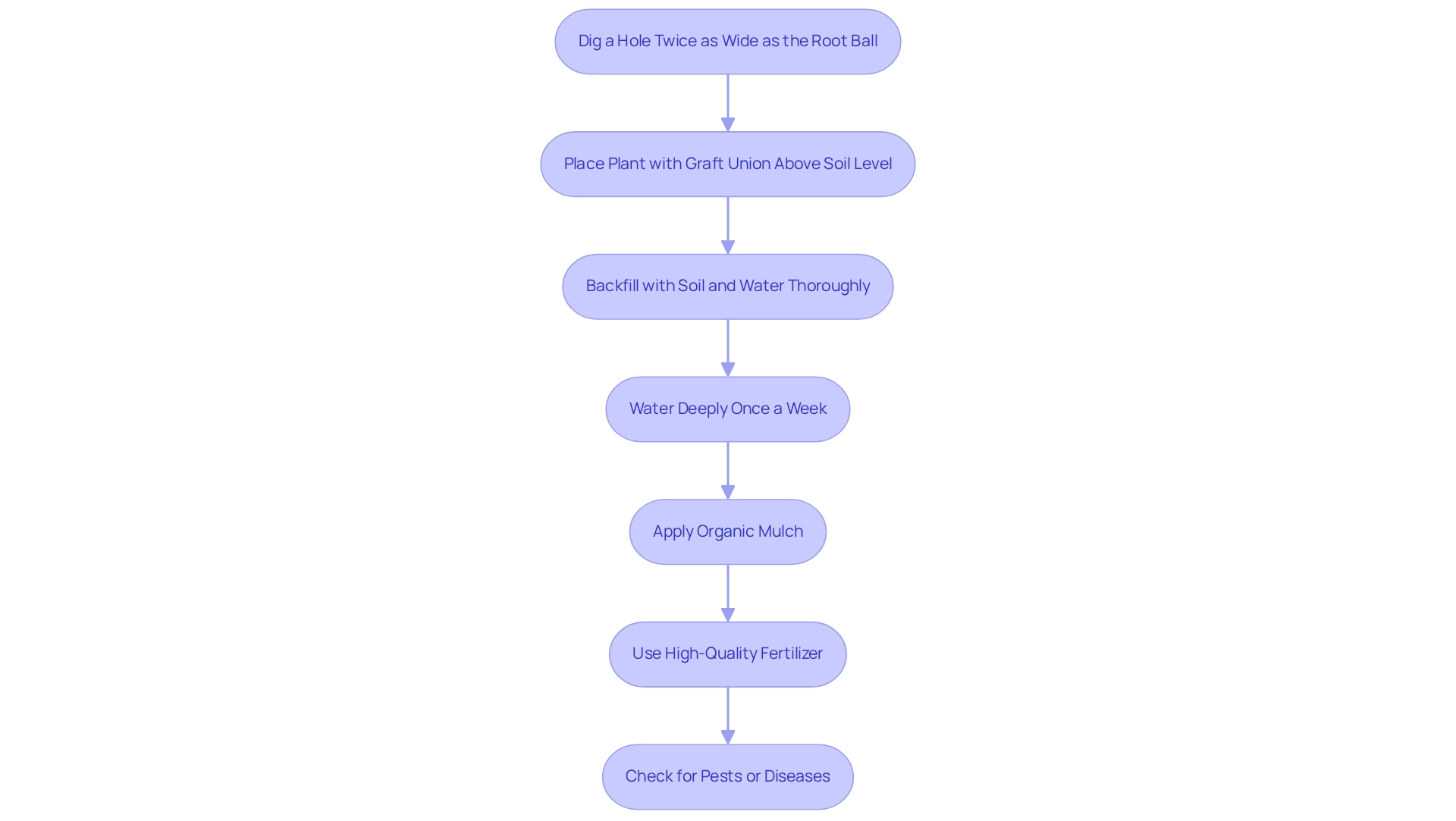
How to Choose Full Size Fruit Trees for Your Garden
Share
Choosing full-size fruit trees for your garden can feel like a daunting task, but it doesn't have to be. Start by evaluating your garden's unique requirements. What does your space need? Next, explore suitable varieties that thrive in your climate—this is where the journey begins. Selecting a reputable nursery is crucial; you want to ensure that your trees come from a trusted source.
As you embark on this adventure, remember the importance of soil quality, sunlight, space, and water drainage. Each of these elements plays a vital role in the health and growth of your trees. Informed choices regarding tree varieties and proper care techniques are essential for ensuring successful growth and a bountiful yield.
Think of your garden as a nurturing space, one that requires attention and love. By following best practices for planting and care, you are setting the stage for a fruitful experience. So, take a moment to reflect on your gardening goals. What do you hope to achieve? With patience and dedication, your garden can flourish, bringing joy and sustenance to you and your loved ones.
Want to grow your own lush orchard at home?
Choosing full-size fruit trees can feel overwhelming, but it’s easier than you think—if you know what to look for. From understanding your garden’s needs to selecting the right varieties and nursery, we’ll guide you through four key steps for success.
👉 Browse Full Size Fruit Trees at Everglades Farm — expertly grown trees shipped with care.
Whether you're aiming for mangoes, avocados, or guavas, Everglades Farm has a collection of Fruit Trees, Fast Growing Trees, and Dwarf Fruit Trees to suit your needs.
Cultivating full-size fruit trees in your garden can be a truly rewarding endeavor, but it often comes with its own set of challenges. Have you ever wondered about the best way to assess your soil quality or how much sunlight your trees will need? Each step, from selecting the right varieties for your climate to understanding the nuances of care, plays a crucial role in ensuring the health and productivity of your trees. Choosing a reputable nursery and implementing best practices for planting can make a world of difference. Together, we can transform your garden into a thriving orchard.
This guide will explore essential strategies that you, as an aspiring gardener, can adopt to nurture your fruit trees successfully. By understanding these practices, you’ll be paving the way for a bountiful harvest that you can share with friends and family. Let’s embark on this journey together, nurturing not just trees but also a love for gardening that will flourish for years to come.
1. Identify Your Garden's Requirements for Full-Size Fruit Trees
-
Evaluate Ground Quality: Let's start by taking a moment to examine the pH level and nutrient content of your soil. These factors are vital for the health of your mature fruit trees. Ideally, they flourish in well-drained, loamy earth that is rich in organic matter. Using a testing kit can provide you with valuable insights into your soil's composition, helping you make informed choices for optimal growth. Remember, quince plants can live for 30-40 years, so the condition of your soil is significant for the long haul.
-
Assess Sunlight Exposure: Sunlight is crucial for the growth of fruit-bearing plants, with most varieties requiring at least 6-8 hours of direct sunlight each day. To find the best spots in your garden, take some time to observe how sunlight moves across your space throughout the day. This will help you identify areas that receive adequate exposure, which is essential for maximizing yield and quality. Based on a case study about managing canopy for light exposure, remember that appropriate pruning and shaping are key to enhancing light access, ultimately improving the size, color, and overall quality of your produce.
-
Measure Available Space: Consider the mature size of the plants you wish to cultivate. It’s important to ensure enough spacing to prevent overcrowding, which can lead to poor air circulation and increase the risk of diseases. Adequate spacing allows each plant to access essential resources, promoting healthier growth and yield. Additionally, limb orientation plays a role in vigor and fruiting; aiming for a 60-degree angle is ideal for optimal development.
- Consider Water Drainage: Effective drainage is essential to avoid waterlogging, which can damage plant roots. Take a moment to assess your garden's drainage capabilities; if it tends to retain water, think about implementing raised beds or planting in mounds. This practice not only enhances drainage but also improves soil aeration, contributing to the overall health of your plants.

2. Explore Varieties of Full-Size Fruit Trees Suitable for Your Climate
-
Research Climate Zones: Understanding your USDA hardiness zone is essential for nurturing plants that will thrive in your garden. Tropical plants, for instance, typically flourish in warmer regions (10-11). As an expert gardening specialist wisely observes, "Roots planted in spring have several months to grow until temperatures drop and will better withstand the winter temperature fluctuations." This knowledge empowers you to make informed choices.
-
Choose Appropriate Types: When selecting plants, consider options such as full size fruit trees for sale like mangoes, avocados, and guavas, which love warm climates. Delve into their specific needs—sunlight, water, and soil conditions are crucial for their success. Research shows that planting in spring allows for better root establishment, a key factor for these beautiful, fruitful plants.
-
Consider Pollination Requirements: Did you know that some fruit-bearing plants require cross-pollination to bear fruit? It’s important to check whether the varieties you’re interested in need a pollinator, and plan accordingly. This step can significantly enhance your gardening success.
- Look for Disease Resistance: Opt for varieties known for their resilience against common pests and diseases in your area. This choice will reduce the need for chemical treatments and promote healthier plants. Statistics reveal that selecting disease-resistant varieties can greatly enhance both yield and plant vitality in specific USDA zones.
By considering these factors, you’ll be on your way to cultivating a vibrant garden filled with thriving plants. Remember, every step you take brings you closer to a flourishing oasis in your backyard!

3. Select a Reputable Nursery and Assess Tree Quality Before Purchase
-
Research Nurseries: When embarking on your gardening journey, it's essential to find nurseries that specialize in tropical fruit plants and have garnered positive customer reviews. Everglades Farm stands out with its strong reputation for excellence and exceptional customer service, as evidenced by 79% of reviews rating their service as five stars. Customers like Jim C. have praised the condition of their plants upon delivery, noting that his Mauritius lychee specimen arrived in excellent shape—an indication of the nursery's commitment to quality. Additionally, Mark Spurgeon highlighted the meticulous packaging of his coconut cream grafted mango, which also arrived in perfect condition, setting a positive contrast to experiences with other retailers. Their dedication to quality and customer experience makes them a preferred choice for online nursery shopping.
-
Examine Plants Physically: If you have the opportunity to visit a nursery, take a moment to look for specimens with vibrant leaves, sturdy trunks, and healthy root systems. It's wise to steer clear of any plants exhibiting yellowing leaves or signs of disease, as these can signal underlying health issues that may hinder your gardening success.
-
Ask About Care Practices: Don’t hesitate to inquire about the cultivation and maintenance methods used for the plants. Well-cared-for plants are more likely to thrive in your garden, enhancing the beauty of your landscape. For example, Susan Reece shared her excitement about her Ruby Supreme Pink Guava plant, which, despite experiencing some leaf drop due to shipping stress, is already producing baby guavas—an encouraging sign of a healthy start.
- Check for Guarantees: Reputable nurseries often provide guarantees on their plants, offering reassurance about your investment. This commitment to quality is crucial, as it reflects the nursery's confidence in their products. However, it's important to consider customer feedback; for instance, John P. Miller expressed disappointment with plants that were 'dried out' and 'rotting on a couple ends,' underscoring the necessity of careful selection.
By following these thoughtful steps, you can confidently choose a nursery that prioritizes quality and customer satisfaction, paving the way for a successful gardening experience.

4. Follow Best Practices for Planting and Caring for Your New Fruit Trees
To ensure the optimal growth of your passion plant and soursop plants, start by digging a hole that is twice as wide as the root ball and the same depth. Place the plant so that the graft union is above soil level, then backfill with soil and water thoroughly to eliminate air pockets. When choosing your passion fruit variety, consider your local climate and the specific needs of the plant.
Newly planted seedlings require consistent moisture to establish their roots. Water deeply once a week, adjusting for rainfall and temperature fluctuations. This practice is essential, as improper watering can lead to stress or even the death of your plants. Focus on irrigating the root area rather than the trunk or foliage, as emphasized in the case study on irrigation and plant health.
Applying a layer of organic mulch around the base of the plant is beneficial. This not only helps maintain moisture but also controls weeds and manages soil temperature, creating a more stable environment for growth.
Utilize a high-quality fertilizer designed specifically for produce to promote healthy development. Follow the producer's instructions regarding application rates and timing to enhance effectiveness.
Regularly check your plants for any signs of pests or diseases, especially passion vine hoppers that can affect passion vines. Employ integrated pest management techniques to preserve plant health while minimizing chemical use, ensuring a sustainable approach to gardening. Identifying and managing these pests is crucial for the vitality of your tropical fruit trees, particularly if you are looking at full size fruit trees for sale; by incorporating these best practices, you will not only enhance the vitality of your fruit trees but also contribute to a fruitful and rewarding gardening experience. Remember, gardening is a journey we take together, and every step you take is a step toward nurturing your green sanctuary.

Conclusion
Successfully cultivating full-size fruit trees begins with careful planning and attention to detail. Have you considered assessing your soil quality, evaluating sunlight exposure, and ensuring proper spacing? These foundational steps set the stage for thriving trees. By understanding your garden’s specific needs, you can create an environment that promotes healthy growth and abundant fruit production.
Selecting the right varieties suited to your climate is equally important. Researching climate zones, pollination requirements, and disease resistance can significantly enhance your chances of success. Choosing varieties that align with your local conditions not only improves yield but also fosters a resilient garden ecosystem.
The process of selecting a reputable nursery and ensuring the quality of the trees is vital. By opting for nurseries with positive reviews and healthy plants, you can invest with confidence. Following best practices for planting and ongoing care—such as proper watering, mulching, and pest management—will further bolster the health of your fruit trees.
In summary, nurturing a flourishing orchard involves a harmonious blend of knowledge, care, and commitment. By implementing these strategies, you can transform your space into a productive orchard, sharing the fruits of your labor with family and friends for years to come. Embracing this journey not only enhances your gardening skills but also fosters a deeper appreciation for nature's bounty. Together, let’s cultivate a garden that thrives and brings joy to our lives.
🌳 Ready to Plant Your Dream Orchard?
Find the perfect full-size fruit trees for your home garden with Everglades Farm. With top-rated shipping, support, and variety selection, growing fruit has never been easier.
🔗 Explore More:
Frequently Asked Questions
Why is it important to evaluate ground quality before planting fruit trees?
Evaluating ground quality is crucial because the pH level and nutrient content of the soil significantly affect the health of mature fruit trees. Ideally, they thrive in well-drained, loamy soil rich in organic matter.
How can I test the quality of my soil?
You can use a testing kit to assess your soil's pH level and nutrient content. This information will help you make informed decisions for optimal growth and ensure the long-term health of your plants.
How much sunlight do fruit-bearing plants need?
Most fruit-bearing plants require at least 6-8 hours of direct sunlight each day for healthy growth. Observing how sunlight moves across your garden can help you identify the best spots for planting.
What role does pruning play in sunlight exposure for fruit trees?
Appropriate pruning and shaping of fruit trees are key to enhancing light access, which can improve the size, color, and overall quality of the produce.
Why is it important to measure available space for planting?
Measuring available space is important to prevent overcrowding, which can lead to poor air circulation and increased disease risk. Adequate spacing allows each plant to access essential resources for healthier growth and yield.
What is the ideal limb orientation for fruit trees?
The ideal limb orientation for optimal development of fruit trees is a 60-degree angle, which promotes vigor and fruiting.
How does water drainage affect fruit tree health?
Effective water drainage is essential to avoid waterlogging, which can damage plant roots. Poor drainage can hinder plant health, so assessing drainage capabilities is important.
What can I do if my garden retains water?
If your garden tends to retain water, consider implementing raised beds or planting in mounds. This practice enhances drainage and improves soil aeration, contributing to the overall health of your plants.


